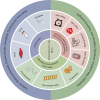Medical laboratory data-based models: opportunities, obstacles, and solutions
- PMID: 40707923
- PMCID: PMC12291381
- DOI: 10.1186/s12967-025-06802-x
Medical laboratory data-based models: opportunities, obstacles, and solutions
Abstract
Medical Laboratory Data (MLD) models, which combine artificial intelligence with big medical data, have great potential in disease screening, diagnosis, personalized medicine, and health management. This study thoroughly examines the opportunities, challenges, and solutions in this field. The use of large-scale MLD improves diagnostic accuracy and allows for real-time disease monitoring. Additionally, integrating social and environmental data enables the analysis of disease mechanisms and trends. Despite these benefits, challenges such as data quality, model optimization, computational requirements, and limited interpretability remain, along with concerns about data privacy, fairness, and security. Proposed solutions include establishing standardized data formats, utilizing deep learning frameworks, employing distributed computing, improving interpretability, and implementing techniques like federated learning and algorithm optimization to address bias and safeguard privacy. Future directions will focus on enhancing performance in specific scenarios, expanding applications across different domains, increasing transparency, enabling real-time processing, and building a supportive ecosystem. It is essential to strengthen policy oversight and promote collaboration among governments, medical institutions, and academia to ensure that technological advancements align with societal progress.
Keywords: Large models; Medical laboratory data; Obstacles; Opportunities.
Conflict of interest statement
Declarations. Ethics approval and consent to participate: Not applicable. Consent for publication: Not applicable. Competing interests: The authors declare that they have no competing interests.
Figures


Similar articles
-
Voluntary community service in medical school: a qualitative study on obstacles faced by student leaders and potential solutions.Glob Health Action. 2015 Oct 20;8:27562. doi: 10.3402/gha.v8.27562. eCollection 2015. Glob Health Action. 2015. PMID: 26490690 Free PMC article.
-
Use of artificial intelligence in critical care: opportunities and obstacles.Crit Care. 2024 Apr 8;28(1):113. doi: 10.1186/s13054-024-04860-z. Crit Care. 2024. PMID: 38589940 Free PMC article. Review.
-
The funding of specialised paediatric palliative care in Switzerland: a conceptualisation and modified Delphi study on obstacles and priorities.Swiss Med Wkly. 2023 Dec 8;153:3498. doi: 10.57187/s.3498. Swiss Med Wkly. 2023. PMID: 38579319
-
Challenges and Opportunities in Using Twitter as a Pedagogical Tool in Pathology and Laboratory Medicine Education.Am J Clin Pathol. 2022 Jun 7;157(6):836-843. doi: 10.1093/ajcp/aqab219. Am J Clin Pathol. 2022. PMID: 35050345
-
Biosensor markets: opportunities and obstacles.Med Device Technol. 1995 Mar;6(2):32-7. Med Device Technol. 1995. PMID: 10184423 Review.
References
-
- Goeminne LJE et al. Plasma protein-based organ-specific aging and mortality models unveil diseases as accelerated aging of organismal systems, (in eng), Cell Metab, vol. 37, no. 1, pp. 205–222.e6, Jan 7 2025, 10.1016/j.cmet.2024.10.005 - PubMed
Publication types
Grants and funding
LinkOut - more resources
Full Text Sources

